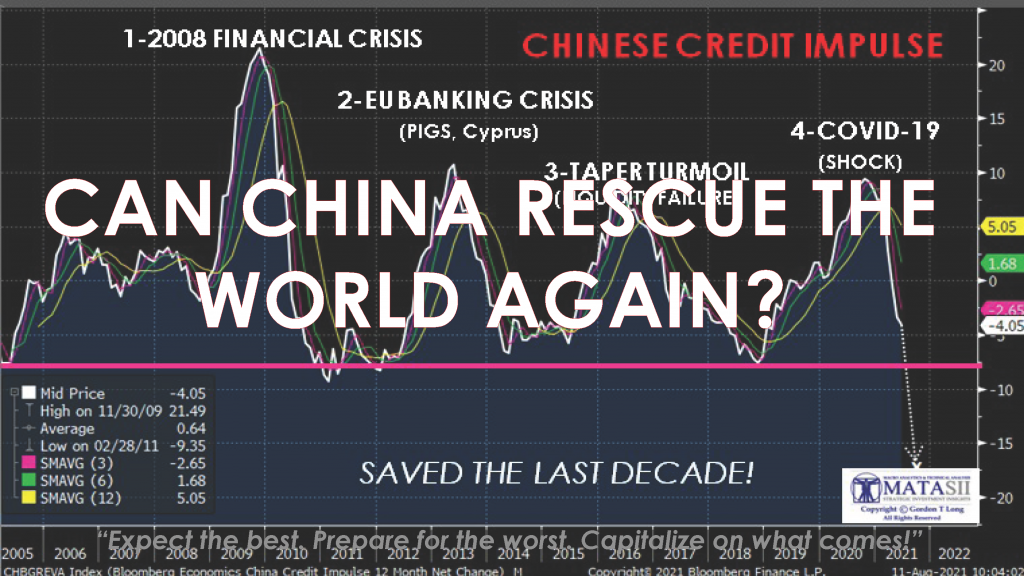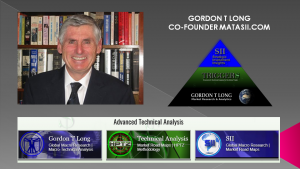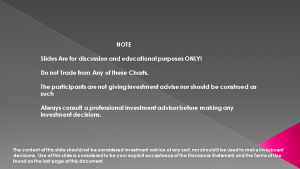IN-DEPTH: TRANSCRIPTION - UnderTheLens - 09-20-23 - OCTOBER – Can China Rescue the World Again?
SLIDE DECK
TRANSCRIPTION
SLIDE 2
Thank you for joining me. I'm Gord Long.
A REMINDER BEFORE WE BEGIN: DO NO NOT TRADE FROM ANY OF THESE SLIDES - they are COMMENTARY for educational and discussion purposes ONLY.
Always consult a professional financial advisor before making any investment decisions.
SLIDE 3 - COVER
The degree of slowdown in the Chinese economy has taken many by surprise in 2023. Most fully expected that China’s economic growth rate would inevitably slow but not quite abruptly as it has!
The reasons are turning out to be a dangerous combination of both domestic and international issues which are quickly taking their toll on a global economy that has become dependent on China as a global industrial power!
SLIDE 4
“It’s a moment of great uncertainty, and arguably the moment of least confidence, surrounding the Xi administration,”
- Consumers are gloomy.
- Private investment is sluggish.
- A big property firmis near collapse.
- Local governments face crippling debt.
- Youth unemployment has continued to rise.
The economic setbacks are eroding Mr. Xi’s image of imperious command, and emerging as perhaps the most sustained and thorny challenge to his agenda in over a decade in power.
He was committed to taming the debt-laden real estate sector even as home sales fell.
President. Xi’s government now confronts a tangle of difficult choices. On the one hand, he may have to give more freedom to private businesses and financial support to debt-saddled local governments. On the other hand, he may have to apply more of his power to push through painful steps that some experts say are needed to fix the economy and state finances, such as introducing new taxes.
I want to delve into the issues so we better understand what may be ahead that we are not yet prepared for.
As such I would like to cover the areas I have outlined here.
SLIDE 5
We need to start with a full understanding and appreciation that it has been China that has kept the global economy stable since the Financial Crisis of 2007-2008.
Since then on four separate occasions as shown here it was China inserting massive credit and liquidity into the global economy through what is referred to as the Chinese Credit Impulse that avoided major global economic problems.
The major question today, as a G7 wide Recession is highly likely ahead, is whether China will – or even can -- once again ride to the rescue? Without China shouldering the load of the “Soft Landing”, that many now expect, will be much harder, protracted and frankly dangerous.
SLIDE 6
The current status of the Chinese Credit Impulse is shown here, overlaid with Chinese Housing Prices (in gold) and the Chinese stock market (in red).
The light blue lines highlight the Credit impulse since 2006 which can be seen to be at the slowest level since 2008 and where previously it has abruptly risen as China opened up the required credit spigot.
However, this time the Chinese Real Estate market both commercially and in public shelter is at an all time low – not a high as when credit was previously needed!
SLIDE 7
Anyone, even mildly familiar with the Chinese economy understands how the real estate property market completely dominates it.
The Chinese property market is considered to be the largest asset class in the world – ever mind just China.
So, any problems in this area and China has major problem.
SLIDE 8
Our Chinese Credit Impulse with Real Estate at lows, as shown here, having taken the Chinese market with it.
Again, the question is what can we expect China to do?
China is fully aware that opening the Credit spigot once again will this time have devastating and long lasting negative effects. Consequently the CCP is committed to growing domestic consumption and its 1.4B consumers. However, this is not working for two reasons:
- Chinese Consumers culture is one of saving (at least to the best they afford) and investing in the only real investment they trust which is real estate,
- The Chinese System is not built to be consumer focused and that transition is proving extremely difficult for a centrally planned system managed by one party aimed at staying in power and filled with a culture of quite corrupt officials at all levels.
SLIDE 9
So let’s look more closely at what is going wrong in China and the challenges facing the CCP.
SLIDE 10
The chronic illness in China is the massive debt load in both the corporate and household sectors.
China’s household debt level relative to disposable income is the highest among the major economies … and this is with a culture oriented towards saving to survive?
SLIDE 11
China now finds itself mired in a Deflationary Debt Spiral.
SLIDE 12
Chinese Households are focused on deleveraging as housing craters – not spending and increasing consumption.
What we have is what Japan experienced after its spectacular growth in the late 70’s and 80s … a Balance Sheet Recession…
SLIDE 13
The Private Sector is also Deleveraging and saving, however this is resulting in growing bank deposits.
SLIDE 14
What this combination results in is effectively a Structural Demand Loss!
This is more than just about the Chinese Covid lockdowns which obviously temporarily slowed economic activity.
SLIDE 15
Like the US prior to 2008, and as I already mentioned, Chinese household leverage is concentrated in property. Every time that external demand lagged over the last decade, Beijing’s policymakers used the household credit lever, propping up the economy by stimulating real estate.
Real Estate Was Used to Offset External Demand Weakness throughout the last Cycle.
SLIDE 16
The CCP in their recent Party Congress and Policy Setting meetings have consciously decided to stop what must be termed a debt super cycle. This comes with predictable outcomes!
Property prices as a consequence have declined.
SLIDE 17
While property sales are contracting, sales are stagnating!
SLIDE 18
While there are secular reasons for the flagging demand – such as negative effects from demographics ... Demographics are certainly not helping.
SLIDE 19
… the main culprit is the unwillingness of policymakers to deal with the private-sector balance-sheet recession.
In the West, the secular stagnation cycle post-2008 took nearly a decade to resolve. This was primarily because policymakers failed to heed the advice that fiscal stimulus was the only way to deal with private-sector deleveraging.
In both the US and Europe, policymakers stuck to monetary policy, eschewing the fiscal lever.
Politics played a major role, with the rise of the Tea Party in the US and the austerity fetish in Europe which delayed the fiscal response.
Once populist outcomes began to mount – particularly in the monumental year of 2016 – the fiscal lever was re-engaged with gusto.
SLIDE 20
It is unlikely that Beijing will wait seven years (as the West did) to cycle through such a rate cuts-QE-fiscal stimulus playbook. Political pressures are already building, with youth unemployment and household income indicative of a deep domestic malaise.
Ultimately, the West responded to its own balance-sheet recession with stimulus. China will as well, but likely on a faster time horizon.
When that moment eventually comes, it will combine with the investment boom in the US to create a significant Capex-led cycle.
Such cycles tend to be positive for global equities and commodities and negative for bonds
The exact opposite, in other words, of what worked during the post-GFC, secular stagnation, “risk parity” cycle.
As long as Beijing hesitates, however, investors won’t know which paradigm they are in.
There might be a lot more push-and-pull between the risk-parity default setting of most investors and the Capex-led cycle yearned for by value investors, commodity bulls, and fans of cyclical assets.
But once China puts a floor under its growth, the shift to the new paradigm should become clear.
SLIDE 21
The biggest threat during this likely protracted transition is going to global liquidity.
China is going to be a drain on liquidity, not the pump!!
Let’s explore that.
SLIDE 22
Simon White at Bloomberg has done some interesting work in that regard.
He also believes that global money growth will remain under pressure while China refrains from comprehensive easing, posing a potential secular headwind for risk assets and economic growth around the world.
Money makes the world go round. Nowhere is that more true than in markets. No money, no liquidity, no transactions. Any impediments to money are thus a big deal for asset prices and economies.
Money has been in great abundance for most of the last 20 years. But that is in large part due to China. Its current travails therefore pose a significant risk to money’s path in the coming months and years.
China’s dominance in global money trends can be seen in this chart.
Since 2007, China’s M1 in dollar terms has hugely outpaced GDP-weighted M1 in the rest of the world. M1 in China is ~ $9.5 trillion, while M1 in the US, the country with the second largest stock of narrow money after China, is 30% lower, despite an economy that is a third bigger than China’s.
That’s without including the demand deposits of households. They’re not part of M1 in China as they are in most other countries. Adding them in would enlarge China’s M1 by more than half again.
SLIDE 23
Even without this adjustment, China has been pivotal for global money growth over the last 15 years. That can be seen clearly if we look at the first principal component of global money growth, that is where there is maximum variation.
This component is very close to China’s money growth (and no other countries, including the US), showing that China has been the primary driver of global money trends for the last two decades.
SLIDE 24
At no time was China’s global monetary significance more critical than in the aftermath of the GFC. While the US was hesitating in providing large-scale fiscal and monetary stimulus, China’s money growth exploded. Between 2008 and 2011, it was on average about twice the rate than in the rest of the world.
In percentage terms, M1 in the rest of the world rose by 30% in 2008-11, while in China, adjusted for household deposits, it climbed by almost 110%. It’s no overstatement to say a deep recession could well have become a global depression if it were not for China’s largesse.
In the pandemic the situation was reversed, but less dramatic. The US expanded its money supply more than China as the latter refrained from supporting its household sector, while the US handed out stimulus checks. But to put things in perspective, the gap between M1 growth in the pandemic was much smaller than in the GFC, at 14% for China compared to only 38% for the rest of the world. The rest of the world is not providing the money leadership China once did.
Why isM1 is so important?
Principally as it’s the most cyclical of the monetary measures. The monetary base, which is currency in circulation and bank reserves, is too narrow a measure. Central-bank reserves can be created but remain locked up in the financial system, and thus have a muted impact on risk assets and especially the real economy.
M2 and M3, on the other hand, are too broad measures of money. They are typically counter-cyclical as they are dominated by items like savings deposits, which tend to rise in periods of risk aversion and fall when economic optimism rises.
M1 is in a sweet spot. It’s primarily made up of the monetary base and demand deposits. Banks create deposits when they lend money, thus it is an excellent sign of forthcoming economic activity. Why borrow unless you are going to spend or invest?
SLIDE 25
M1’s evolution, therefore, has significant implications for risk assets and global economic activity. We can see in this chart the strong leading relationship between global M1 growth and US equities, with rises and falls in M1 growth leading stocks by about six months.
SLIDE 26
But since the pandemic, China has been faltering. For the first time since it entered the global financial system, China has been a persistent drag on global money growth.
Its M1 growth has stalled as it imposed some of the most draconian lockdowns in the world, and since then it has resisted engaging in so-called flood-like stimulus to reflate its economy.
Without China, global money supply is likely to remain depressed, especially as growth is unlikely to come from the US et al when they are in the midst of rate-hiking cycles and reducing the size of their central-banks’ balance sheets.
The pressure is mounting on China to stimulate broadly to resuscitate its property market and avert a debt-deflation. But that doesn’t mean it will definitely happen, and MOST IMPORTANTLY happen in time.
If resistance to such measures turns into outright recalcitrance, then it’s not just China that will face the consequences.
SLIDE 27
There are many problems in China hat we don’t really have an appreciation for.
They center on policy decisions which are taken by the centrally planned and controlled Chinese Communist Party or CCP.
Let me just run through a few that are obvious and important and spelled out by James Gorrie in his excellent book “The China Crisis” published in 2012. Many of the points he highlighted as “Achilles Heels” for China are still valid.
SLIDE 28
Excessive Overuse of Factors of Production
When greasing the palms of Party officials is the main requirement for a project or policy, waste and fraud are not only unavoidable but lead to inefficiency in leveraging factors of production. In 2013, China used 10 times more factors of production than the United States to produce the same product. Has that improved? It’s hard to say, as accurate statistics that reflect poorly on the CCP and Xi Jinping, in particular, are difficult to find.
SLIDE 29
Inefficient Allocation of Economic Goods, Activity
This is related to the first point and is manifested in many ways, such as the theft of profitable companies by the Party and turning them into inefficient, debt-ridden "zombie" state-owned enterprises that destroy value and efficiency. It also transfers wealth from the middle class to the Party elite.
SLIDE 30
Stifling Innovation in Middle Class
Lack of freedom of information and the punishment of violators stifles innovation and creativity. Individuals are not allowed to solve problems by themselves. Successful private firms can count on being confiscated by the state at some point. Successful entrepreneurs who speak out about the abuses of the CCP are disappeared and reeducated. This engenders total fear of and reliance upon the state, both of which are what the CCP wants. Crushing individual creativity and innovation stifles a nation’s greatest resource—its people.
SLIDE 31
Lack of Enforcement of Regulations, Standards
From critical areas such as food production to pharmaceuticals, corners are cut, and quality is compromised. Over the years, this not only negatively impacts the health and safety of the people, but it undercuts the authority and legitimacy of the Party.
SLIDE 32
A False Economy: Debt-based 'Growth' Is a Cancer on Economy
In a capitalist economy, most development is based on market need, which is determined by local prices and market conditions, which then attract capital. Distorted “development” driven by political expediency isn’t development but a waste of time, money, and resources.
The Evergrande collapse is a prime example of the CCP’s distortion of the economy. China’s overreliance on overdevelopment could be compared to healthy growth in muscle tissue from working out versus that of a cancerous tumor from exposure to toxicity. The former builds up strength and vitality; the latter destroys it. Thus, at some point, even state-owned debt from a state-owned central bank becomes unsustainable.
SLIDE 33
Rampant Pollution Making China Unlivable, Causing Social Unrest
China is one of the worst polluters in the world. For example, it is rapidly losing its arable land to toxicity from mining, manufacturing, and desertification. This is happening because decades of state ownership have led to indifference about what happens to the natural resources, also known as the “tragedy of the commons.” Losing arable land by either toxicity or desertification is not easily reversible and leads to greater dependence on external food sources to feed itself.
Water pollution is another environmental disaster brought about by the CCP. In 2012 about 40 percent of China’s waterways either could not sustain life or were unsafe for human consumption. Today, that number is up to 70 percent. Moreover, 80-90 percent of its groundwater is undrinkable.
China’s air pollution is known for being the worst in the world, responsible for millions of premature deaths. State officials claim that air pollution is decreasing in China. Yet, at the same time, China is adding more coal mines for energy production, leading to more pollution, not less. The CCP’s inability to address its pollution crisis reveals its economic model's failures, adding to civil unrest rather than social support.
SLIDE 34
Dystopian Depression among Young Generation
When young people lose faith in their nation, they lose faith in their future. One outcome of that pessimism is the decision not to have children. China is not alone in this phenomenon, but like South Korea and Japan, it’s a big problem. Without the energy, drive, creativity, and belief of the young, the fall in population and its effects on consumption, taxes, and other economic factors make China’s economic future bleak.
Unfortunately, its unbalanced social and economic structure will lead to more excessive actions, internally and externally, as economic and social conditions worsen.
SLIDE 35
So what should we conclude?
SLIDE 36
China is in for some tough times that are only beginning as the global economy slows and puts further pressure on the global manufacturing power house as orders fall.
A slowing economy normally means layoffs in a manufacturing dominated economy.
With 1.4B people, many of which have left the rice paddies for work in the urban centers layoffs are something China has not really underwent.
The closest it came was in 2008. I recall how 28M were caught at railroad stations trying to get to their ancestral farm homes as the slowdown with some layoff s hit.
This time the layoffs could easily be in the 100’s of million. These are unimaginable numbers for countries like the US with a population of only 320M
SLIDE 37
A bigger problem however it that the only power the CCP has is given to them by the people to ensure stability and jobs. They are willing to tolerate the CCP only if they deliver on these expectations of their sole role!
Without it the CCP will quickly become the enemy if the people.
The CCP know this only too well.
There is an old Chinese proverb: “May You Live in Interesting Times”
We may here that Proverb a lot more in the coming years coming out of China!!
SLIDE 38
As I always remind you in these videos, remember politicians and Central Banks will print the money to solve any and all problems, until such time as no one will take the money or it is of no value.
That day is still in the future so take advantage of the opportunities as they currently exist.
Investing is always easier when you know with relative certainty how the powers to be will react. Your chances of success go up dramatically.
The powers to be are now effectively trapped by policies of fiat currencies, unsound money, political polarization and global policy paralysis.
SLIDE 39
I would like take a moment as a reminder
DO NO NOT TRADE FROM ANY OF THESE SLIDES - they are for educational and discussions purposes ONLY.
As negative as these comments often are, there has seldom been a better time for investing. However, it requires careful analysis and not following what have traditionally been the true and tried approaches.
Do your reading and make sure you have a knowledgeable and well informed financial advisor.
So until we talk again, may 2023 turn out to be an outstanding investment year for you and your family?
I sincerely thank you for listening!





